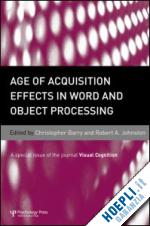
Questo prodotto usufruisce delle SPEDIZIONI GRATIS
selezionando l'opzione Corriere Veloce in fase di ordine.
Pagabile anche con Carta della cultura giovani e del merito, 18App Bonus Cultura e Carta del Docente
Models of word and object processing have been informed by experimental data relating to the effects of important marker variables, particularly word frequency. In recent times, however, the role of word frequency has come to be questioned due to the demonstration of the impact of a correlated variable called "age of acquisition" (AoA), which is an index of when a word was first learned. Early acquired words tend to be of high frequency while late-acquired words tend to be of low frequency. Currently, there is a lively debate in the literature about the operation of AoA and word frequency in word and object processing, and how these effects might be modelled in connectionist architectures. Issues relate to: the relationship between AoA and word frequency; the locus of impact of AoA; and the types of identification task (e.g., recognition, comprehension or naming) that are influenced by the AoA of the target. Originally, AoA was thought to be a factor which operated at a name retrieval stage and which consequently only affected naming responses. However, more recent conceptualizations suggest that AoA effects arise out of the order in which items are learned and consequently may operate on many types of recognition task. Recent demonstrations of AoA effects in non-naming tasks may be seen to favour the latter explanation, but the debate is far from over.
R.A. Johnston, C. Barry, Age-of-Acquisition and Lexical Processing. B.J. Juhasz, K. Rayner, The Role of Age-of-Acquisition and Word Frequency in Reading: Evidence from Eye Fixation Durations. M. Chalard, P. Bonin, Age-of-Acquisition Effects in Picture Naming: Are They Structural and/or Semantic in Nature? S.J. Holmes, A.W. Ellis, Age of Acquisition and Typicality Effects in Three Object Processing Tasks. C. Barry, R.A. Johnston, R.F. Wood, Effects of Acquisition, Age and Repetition Priming on Object Naming. M.A. Lambon-Ralph, S. Ehsan, Age of Acquisition Effects Depend on the Mapping Between Representations and the Frequency of Occurrence: Empirical and Computational Evidence. C.M. Morrison, Z.C. Gibbons, Lexical Determinants of Semantic Processing Speed. J.C. Catling, R.A. Johnston, The Effects of Age of Acquisition on an Object Classification Task. I. Raman, On the Age of Acquisition Effects in Word Naming and Orthographic Transparency: Mapping Specific or Universal? J. Havelka, I. Tomita, Age of Acquisition in Naming Japanese Words. M. Brysbaert, M. Ghyselinck, The Effect of Age-of-Acquisition: Partly Frequency-Related, Partly Frequency-Independent. M.B. Lewis, Chasing Psycholinguistic Effects: A Cautionary Tale. A.E. Hernandez, C.J. Fiebach, The Brain Bases of Reading Late Learned Words: Evidence from Functional MRI.











Il sito utilizza cookie ed altri strumenti di tracciamento che raccolgono informazioni dal dispositivo dell’utente. Oltre ai cookie tecnici ed analitici aggregati, strettamente necessari per il funzionamento di questo sito web, previo consenso dell’utente possono essere installati cookie di profilazione e marketing e cookie dei social media. Cliccando su “Accetto tutti i cookie” saranno attivate tutte le categorie di cookie. Per accettare solo deterninate categorie di cookie, cliccare invece su “Impostazioni cookie”. Chiudendo il banner o continuando a navigare saranno installati solo cookie tecnici. Per maggiori dettagli, consultare la Cookie Policy.